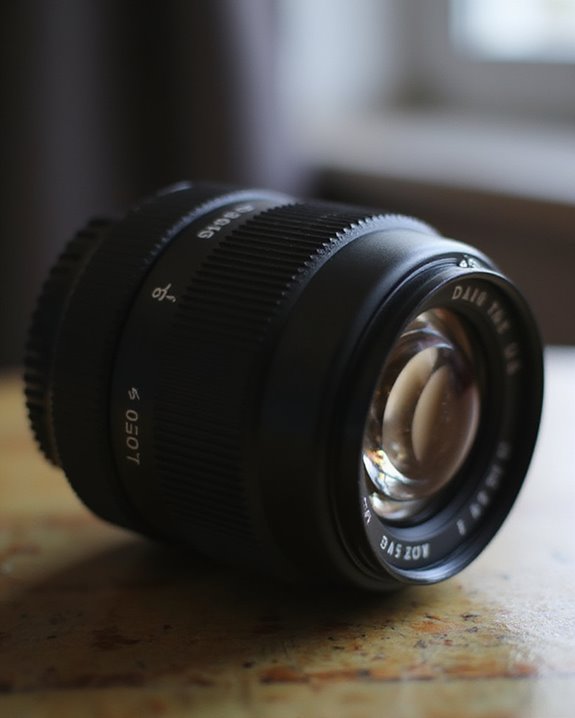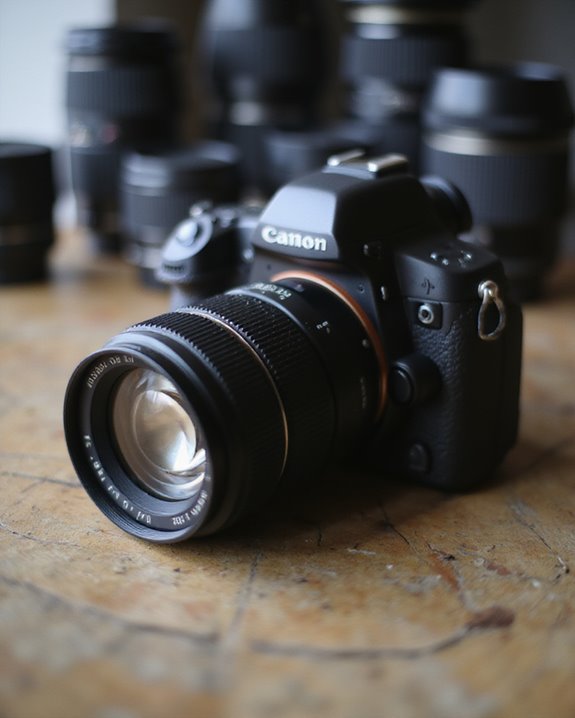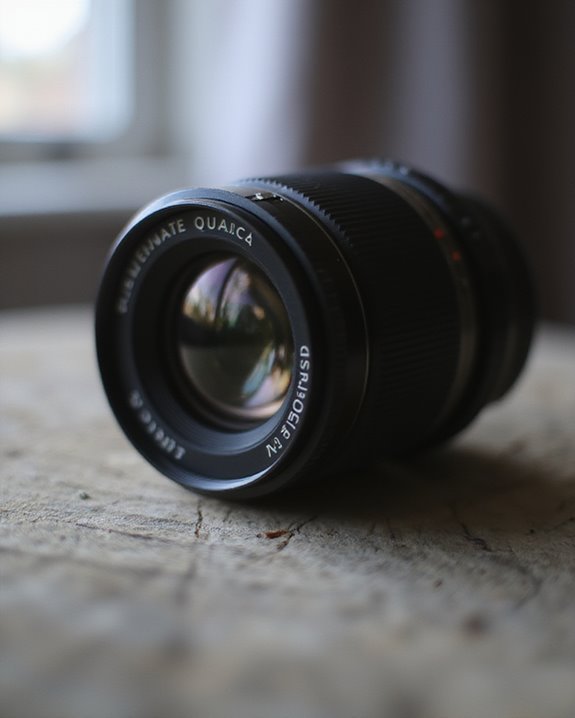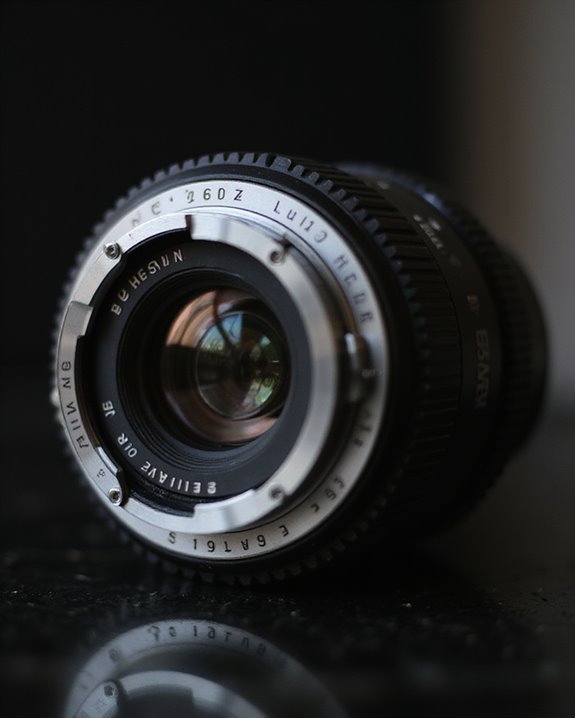A DSLR lens is the optical component that attaches to your camera body, controlling how light reaches the sensor. We rely on these precision-engineered glass elements to determine image quality, focal range, and creative possibilities. Lenses feature various mechanisms including focus rings, aperture controls, and image stabilization systems, with specifications measured in focal length (mm) and maximum aperture (f-stops). Different types—prime, zoom, wide-angle, and telephoto—serve specific photographic purposes, from portraits to landscapes. Further exploration reveals how lens selection dramatically impacts your final images.
Key Takeaways
- A DSLR lens is an interchangeable optical component that attaches to a camera body to capture and focus light onto the sensor.
- DSLR lenses contain multiple glass elements that control focus, magnification, and image quality when taking photographs.
- Common types include prime lenses with fixed focal lengths and zoom lenses that offer variable focal range flexibility.
- Lenses control aperture (measured in f-stops) which affects depth of field and light intake for exposure control.
- DSLR lenses range from wide-angle (below 35mm) to telephoto (above 85mm) with specialized versions for macro, portrait, and landscape photography.
Understanding DSLR Lens Anatomy and Function
A DSLR lens represents a sophisticated optical instrument that’s essential for capturing high-quality images with your digital single-lens reflex camera. When examining a lens’s exterior, we’ll notice several critical components that control its functionality, including focus and zoom rings that adjust the focal length and focus point. The lens hood, typically attached to the front element, serves to reduce unwanted glare and provides physical protection against impacts and environmental elements. Additionally, many lenses feature image stabilization mechanisms that help compensate for camera shake during handheld shooting. To properly attach a lens to your camera body, you’ll need to align the mounting marks—typically colored indicators on both the lens and camera—which guarantee proper connection between these precision instruments. Inside the lens, multiple glass elements work in concert with mechanisms for aperture control, image stabilization, and autofocus motors, all housed within a weatherproof casing that protects these delicate optical components.
The Essential Types of DSLR Lenses Explained

When diving into DSLR photography, understanding the distinct categories of lenses becomes essential for achieving your creative vision and technical requirements. We’ll explore five fundamental types that form the backbone of any photographer’s kit. Prime lenses, with their fixed focal lengths and superior optical quality, have profoundly shaped the Cultural Impact of photography by enabling distinctive Artistic Styles through their wide apertures. Zoom lenses offer versatility across variable focal lengths, while wide-angle lenses (typically 28mm or less on full-frame sensors) excel at capturing expansive landscapes. Telephoto lenses, with their long focal lengths, are indispensable for distant subjects in sports and wildlife photography. Finally, macro lenses specialize in extreme close-up work, revealing intricate details invisible to the naked eye, at magnification ratios of 1:1 or greater. Understanding the lens types for Canon Rebel cameras helps photographers select the right tools to expand their creative possibilities.
How to Choose the Right DSLR Lens for Your Photography

Selecting the ideal DSLR lens involves maneuvering a complex matrix of technical specifications, creative requirements, and practical considerations that will fundamentally shape your photographic output. We recommend aligning your lens selection with your primary photography style, as portrait photographers will benefit from an 85mm prime lens, while landscape enthusiasts should invest in wide-angle options.
Budget planning constitutes a critical component in the decision-making process, with options ranging from entry-level lenses to professional-grade glass. We’ve found that prime lenses often deliver superior quality-to-price ratios compared to zoom alternatives. Additionally, leveraging user feedback through professional reviews and community recommendations provides invaluable insights into real-world performance. For beginners, we suggest starting with a versatile kit lens before gradually expanding your collection based on your evolving photographic preferences and technical requirements.
Understanding the specific features of best DSLR lenses, such as aperture range, focal length, and stabilization capabilities, can help you make more informed choices tailored to your needs.
Aperture, Focal Length, and Image Quality: Technical Aspects

Understanding the technical characteristics of DSLR lenses forms the foundation for making informed equipment decisions that match your photographic vision. Aperture, represented as f-stops, controls both light intake and depth of field, with wider openings (f/1.4) isolating subjects while narrower ones (f/16) extend focus range but introduce diffraction effects that reduce sharpness. Focal length determines your field of view and perspective, with wide-angles exaggerating spatial relationships and telephotos compressing them. We’ve found most lenses achieve best sharpness 2-3 stops below maximum aperture, balancing light transmission and diffraction limitations. Bokeh rendering, influenced by the number and shape of aperture blades, creates that pleasing out-of-focus background essential for portrait and macro work. When comparing lenses, consider whether fixed apertures maintain consistent exposure throughout the zoom range—crucial for professional applications.
Advanced DSLR Lens Features and Technologies

The advanced technology packed into modern DSLR lenses transforms them from simple glass elements into sophisticated optical instruments capable of extraordinary imaging feats. Today’s premium optics feature multiple autofocus motor technologies, including near-silent USM and video-optimized STM systems, with AI integration enabling unprecedented tracking precision through neural networks and predictive algorithms. Stabilization advances have evolved dramatically, with both in-body and lens-based IS systems providing up to 5-stop shake reduction through gyroscopic sensors and floating element designs. Many high-end lenses now incorporate hybrid stabilization that combines optical and digital correction methods, particularly valuable for macro and video applications. Additional innovations include weather-sealed construction with fluorine coatings, firmware upgradability for future AI models, and specialized optics like diffractive elements that dramatically reduce size and weight in telephoto designs.
Frequently Asked Questions
How Often Should I Clean My DSLR Lens?
We recommend cleaning your DSLR lens only when necessary. For proper lens maintenance, inspect regularly but avoid excessive cleaning frequency as it can damage coatings. Clean when you notice dust, fingerprints, or smudges.
Can Vintage Lenses Work With Modern DSLR Cameras?
Yes, vintage lenses can work with modern DSLRs through lens adaptation. We’ve found that with the right adapter compatibility, we can mount these older gems on our cameras, though they’ll typically require manual focusing.
Do Temperature Changes Affect Lens Performance?
While some say it’s minimal, we’ve found temperature changes greatly impact lens performance. Thermal expansion causes materials to contract or expand, creating focus drift that affects sharpness. We recommend gradual temperature shifts for ideal results.
How Long Do DSLR Lenses Typically Last?
We’ve found that DSLR lenses typically last 10-20+ years. Their longevity depends on usage impact—frequent use with proper care extends life, while neglect accelerates deterioration. Quality lenses often outlast camera bodies themselves.
Are Third-Party Lenses as Reliable as Manufacturer-Branded Options?
Like treasure chests with varying keys, third-party lenses can be as reliable as branded ones. We’ve found their performance metrics often match, though warranty differences may favor manufacturer options. Choose wisely based on research.





